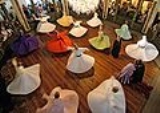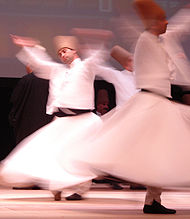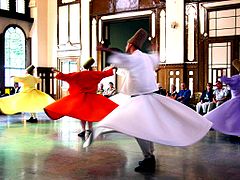
Sufi whirling
Encyclopedia

Sufi whirling is a form of Sama
Sama
Sama may refer to:* A verse from the Samaveda, one of the Vedas* Sama , a part of Harstad city in northern Norway* Sama, Asturias, a parish in the municipality of Langreo in northern Spain...
or physicaly active meditation
Meditation
Meditation is any form of a family of practices in which practitioners train their minds or self-induce a mode of consciousness to realize some benefit....
which orginated among Sufi
Sufism
Sufism or ' is defined by its adherents as the inner, mystical dimension of Islam. A practitioner of this tradition is generally known as a '...
s, and which is still practiced by the Sufi Dervish
Dervish
A Dervish or Darvesh is someone treading a Sufi Muslim ascetic path or "Tariqah", known for their extreme poverty and austerity, similar to mendicant friars in Christianity or Hindu/Buddhist/Jain sadhus.-Etymology:The Persian word darvīsh is of ancient origin and descends from a Proto-Iranian...
es of the Mevlevi order. It is a customary dance performed within the Sema
Sema
Sama is a Sufi ceremony performed as dhikr. Sama means "listening", while dhikr means "remembrance". These rituals often includes singing, playing instruments, dancing, recitation of poetry and prayers, wearing symbolic attire, and other rituals...
, or worship ceremony, through which dervishes (also called semazens) aim to reach the source of all perfection, or kemal. This is sought through abandoning one's nafs
Nafs
Nafs is an Arabic word which occurs in the Qur'an and means self, psyche, ego or soul. In its unrefined state, "the ego is the lowest dimension of man's inward existence, his animal and satanic nature." Nafs is an important concept in the Islamic tradition, especially within Sufism and the...
, egos
Ego (spirituality)
In spirituality, and especially nondual, mystical and eastern meditative traditions, individual existence is often described as a kind of illusion. This "sense of doership" or sense of individual existence is that part which believes it is the human being, and believes it must fight for itself in...
or personal desires, by listening to the music, focusing on God
God
God is the English name given to a singular being in theistic and deistic religions who is either the sole deity in monotheism, or a single deity in polytheism....
, and spinning one's body in repetitive circles, which has been seen as a symbolic imitation of planets in the Solar System
Solar System
The Solar System consists of the Sun and the astronomical objects gravitationally bound in orbit around it, all of which formed from the collapse of a giant molecular cloud approximately 4.6 billion years ago. The vast majority of the system's mass is in the Sun...
orbiting the sun.
As explained by Sufis:
In the symbolism of the Sema ritual, the semazen's camel's hair hat (sikke) represents the tombstone of the ego; his wide, white skirt represents the ego's shroud. By removing his black cloak, he is spiritually rebornRebornReborn may refer to:*Reborn, a Digital Creative Agency in Sydney, Australia*Reborn!, a manga series and a character in the manga*Reborn , a novel by F...
to the truth. At the beginning of the Sema, by holding his arms crosswise, the semazen appears to represent the number one, thus testifying to God's unity. While whirling, his arms are open: his right arm is directed to the sky, ready to receive God's beneficence; his left hand, upon which his eyes are fastened, is turned toward the earth. The semazen conveys God's spiritual gift to those who are witnessing the Sema. Revolving from right to left around the heart, the semazen embraces all humanity with love. The human being has been created with love in order to love. Mevlâna Jalâluddîn Rumi says, "All loves are a bridge to Divine love. Yet, those who have not had a taste of it do not know!"
Origin

Practice
DhikrDhikr
Dhikr , plural ; ), is an Islamic devotional act, typically involving the repetition of the Names of God, supplications or formulas taken from hadith texts and verses of the Qur'an. Dhikr is usually done individually, but in some Sufi orders it is instituted as a ceremonial activity...
"Remembrance of Allah"

Dhikr
Dhikr , plural ; ), is an Islamic devotional act, typically involving the repetition of the Names of God, supplications or formulas taken from hadith texts and verses of the Qur'an. Dhikr is usually done individually, but in some Sufi orders it is instituted as a ceremonial activity...
, a remembering of Allah. The dhikr involves recitation of devotional Islamic prayer. This dhikr is coupled with physical exertions of movement, specifically dancing and whirling, in order to reach a state assumed by outsiders to be one of "ecstatic trances" but which is actually one, not of trance, but of great lucidity and clarity. Among the Mevlevi order, the practice of dhikr is performed in a traditional dress: a tennure, a sleeveless white frock, the destegul, a long sleeved jacket, a belt, and a black overcoat or khirqa to be removed before the whirling begins. As the ritual dance begins, the dervish dons a felt cap, a sikke, in addition to a turban wrapped around the head, a trademark of the Mevlevi order. The sheikh leads the ritual with strict regulations. To begin,
The sheikh stands in the most honored corner of the dancing place, and the dervishes pass by him three times, each time exchanging greetings, until the circling movement starts. The rotation itself is on the left foot, the center of the rotation being the ball of the left foot and the whole surface of the foot staying in contact with the floor. The impetus for the rotation is provided by the right foot, in a full 360-degree step. If a dervish should become too enraptured, another Sufi, who is in charge of the orderly performance, will gently touch his frock in order to curb his movement, The dance of the dervishes is one of the most impressive features of the mystical life in Islam, and the music accompanying it is of exquisite beauty, beginning with the great hymn in honor of the Prophet (na't-i sharif, written by Jalaluddin himself) and ending with short, enthusiastic songs, some things sung in Turkish.
The Western world, having witnessed Sufi whirling through tourism, have described the various forms of dhikr as "barking, howling, dancing, etc." The practice of each tariqa is unique to its individual order, specific traditions and customs may differ across countries. The same tariqa in one country will not mirror that of another country as each order's ritual stresses "emotional religious life" in various forms. The Mevleviyah order, like many others, practice the dhikr by performing a whirling meditation. Accompanying the dhikr practices of whirling and prayer, the custom of sama serves to further one's "nourishment of the soul" through devotional "hearing" of the "'subtle' sounds of the hidden world or of the cosmos." In contrast to the use of sama, whirling and devotional prayer in the practice of dhikr, the tariqa orders perform Sufi whirling in addition to playing musical instruments, consuming glowing embers, live scorpions and glass, puncturing body parts with needles and spikes, or practicing clairvoyance and levitation. The dervish practice can be performed by community residents or lay members, members have typically been those of lower classes. Within Islamic faith, unlike Middle Eastern law, women have equal status to men, allowing women to participate in dhikr as dervishes themselves. Women were received into a tariqa order by a male sheikh, but traditionally were instructed to practice the dhikr alone or with an established branch of females within a specific order. Sufi whirling, a worship of dhikr, became a gender and class neutral practice throughout the Central Islamic region.
Sama
Sema
Sama is a Sufi ceremony performed as dhikr. Sama means "listening", while dhikr means "remembrance". These rituals often includes singing, playing instruments, dancing, recitation of poetry and prayers, wearing symbolic attire, and other rituals...
"Nourishment of the soul"
The custom of sama among Sufi orders has a history of controversy within the Islamic faith. In one argument, the use of the term sama is considered to suggest physically "listening" in a spiritual context. A differing opinion argues that sama is in fact "hearing", as "to hear" can pertain to any sound in addition to any "subtle" sounds of the spiritual realm. Those in support of sama further claim that the term is actually synonymous with "understanding" and therefore recognition and application of the Revelation as well as the act of "attaining higher knowledge." The spread of sama among Sufi orders began some time around the mid 3rd/9th century C.E. in Baghdad, eventually finding acceptance and favor in Persian, Turkish and Indian Islam. The custom of sama evolved in practice over time as it complimented Sufi dhkir, whirling and among some orders dancing and a meal. Rules of propriety and conditions were adopted upon the widespread concern surrounding the necessity of sama with the dhikr; in order to distinguish between entertainment and valuable spiritual practice, the sama was distinguished as heard from the ego, heart or spirit. Despite the application of rules, some sheikhs continued to limit or disapprove the practice of sama. While controversy continuously questioned the place of sama in Sufi orders, the music itself was not affected. More recently, the custom of sama is most commonly performed within a dhikr ceremony. Those in support of sama continue to argue that "according to that which it is not sama and dance which induce ecstasy, but ecstasy which arouses dance, or furthermore, that sama is only a revealing instrument and that it only supplies that which is brought to it by the hearer."
In 2005, UNESCO
UNESCO
The United Nations Educational, Scientific and Cultural Organization is a specialized agency of the United Nations...
proclaimed the "The Mevlevi Sema Ceremony
Sema
Sama is a Sufi ceremony performed as dhikr. Sama means "listening", while dhikr means "remembrance". These rituals often includes singing, playing instruments, dancing, recitation of poetry and prayers, wearing symbolic attire, and other rituals...
" of Turkey
Turkey
Turkey , known officially as the Republic of Turkey , is a Eurasian country located in Western Asia and in East Thrace in Southeastern Europe...
as one of the Masterpieces of the Oral and Intangible Heritage of Humanity
Masterpieces of the Oral and Intangible Heritage of Humanity
The Proclamation of Masterpieces of the Oral and Intangible Heritage of Humanity was made by the Director-General of UNESCO starting in 2001 to raise awareness on intangible cultural heritage and encourage local communities to protect them and the local people who sustain these forms of cultural...
.
Purpose


